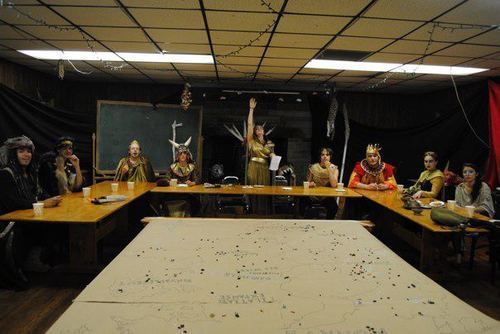Lessons From the LARP Side, Part 2: Setting

Hello there, adventurers! Welcome back to our series about what I’ve learned as a novelist from writing adventure games for Live Action Roleplays. Last week, I gave you an overview of what the gamewriting process looks like. This week we’re going to take a closer look at the process of creating worlds for other people to play in.
Every story, whether novel or game, has a setting. Maybe that setting is a whole new world, with strange beings and stranger magics, or maybe it’s a complex network of planets in the distant future. Maybe it’s an apartment complex in Chicago! No matter what kind of story you’re telling, it has to be set somewhere.
World-building for an adventure game is very similar to world-building for a novel. The biggest challenge is that of perspective. For an adventure game, you’re going to have other people playing in your world, so you have to figure out what they need to know, and then how to convey it. So what, then, do they need to know?
They need to know everything. Surprise!
Your players are going to be acting as characters who live in this created world full-time. They need to have an understanding of how the world works. They need to know the geography, the politics, the social dynamics, the hierarchies, the major figures, the culture, and so on.
Going through this a couple of times, you learn quickly that people aren’t good at processing vast information dumps like that. As such, it’s important to figure out what matters most and concentrate on that. You can come up with all those details in your head, and you can mention them during world background, but they’re not what you need to focus on.
Does the game’s plot revolve around a succession crisis? Then give an in-depth explanation of how the monarchy works. Is it set at a boarding school? Focus on the social dynamics of the upper- and lower-classmen. Each story has different things that matter most about its setting. If you can find these defining characteristics and emphasize them, you’ll get a much stronger and more coherent setting.
Another interesting issue is that of misinformation and lack of information. World background can become an interesting exercise in releasing information calculatedly, which is a fancy way of saying “lying to your players”. I ran a game where I told my fantasy society all about their gods and how much they worshipped these mythical beings, which resulted in a lot of surprise when the gods showed up in-game and turned out to be conquering aliens from another dimension.
You can also use diverse world backgrounds to play with expectations. I recently co-ran a game that involved two cultures locked in a Cold War-like conflict with each other. We separated the players into two separate groups, and then gave them each different, propaganda-fueled information about the opposing side. Each side thought the other was a horrifying wasteland, and that they themselves were clearly the heroic protagonists of the game. When during the game the two armies were forced to work together against a much larger threat, the ensuing culture clash and misconceptions drove a lot of fascinating interactions.

So what lessons can we apply to world-building for a novel? Well… nearly all of it!
1. Figure out the core of your setting.
What elements of the setting matter to the story? What are the central conceits that matter most to the characters and define the story? Figure out those characteristics, and focus on them. Make them shine, and make sure you understand them in detail.
2. Q&A time!
Get a friend (or better, a couple of friends) to come over, and then explain to them everything about your setting. Then have them ask you questions about it. See what comes up! You might be surprised at how much new material you wind up with… and how many holes you have to patch.
3. What do your characters know?
Figure out not just how the setting actually works but how your characters think it works. Their perspective on your world can define their worldview, and, characters with vastly different perspectives, or operating with false information, can lead to some neat developments.
It’s also an important thing to keep track of in a story—unlike in a game, the person controlling the character knows more than they do, so you have to make sure a character isn’t spouting knowledge they shouldn’t know.
Have fun world-building, everyone! Next time we’ll talk about writing characters and their dynamics.
— Ben
Chris Baty's Blog
- Chris Baty's profile
- 62 followers



